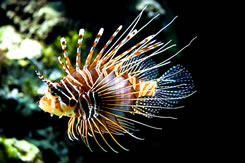Geography

In the past, the red lionfish were only common to the warm waters of the Indo-Pacific region, but in 2002, divers off the coast of North Carolina sighted a mature red lionfish! This was the first solid piece of evidence of red lionfish residing in Atlantic coast waters. Only a year later in 2003, 19 sightings of red lionfish were documented along the Florida and North Carolina coast. Between the years of 2002 and 2004, there were 49 sightings of lionfish ranging from Florida to as far north as Long Island, New York! These documented sightings occurred at 16 different shipwrecks and natural hard bottom locations. Today, over 200 reports of lionfish in the western Atlantic Ocean have been documented since 2002. Many juvenile lionfish have also been reported, indicating that reproduction is taking place.
The question remains in how these lionfish have suddenly become exponentially present over the past few years. One hypothesis is that in 1992, Hurricane Andrew destroyed a beachside aquarium in Biscayne Bay, Florida which released six lionfish. It is also hypothesized that some dive tour guides are intentionally releasing them so they can reproduce and be shown to clients.

Scientists are anticipating lionfish will continue to disperse throughout the Gulf of Mexico, the Florida Keys, and Caribbean Sea. Since the lionfish has such diverse adaptations and few enemies, researchers are claiming that the fish is an almost indestructible species. This in turn could greatly impact native fish populations. Additionally, the venomous spines pose harm to both anglers and divers. To better understand lionfish distribution, density, life history, temperature tolerances and genetics, scientists at NOAA have been conducting research on the invasive lionfish. The research will be used to determine and alleviate potential ecosystem and fisheries impacts due to the presence of lionfish.
To find out why the red lionfish has such great potential to become an invasive species, see the
Adaptation page.


